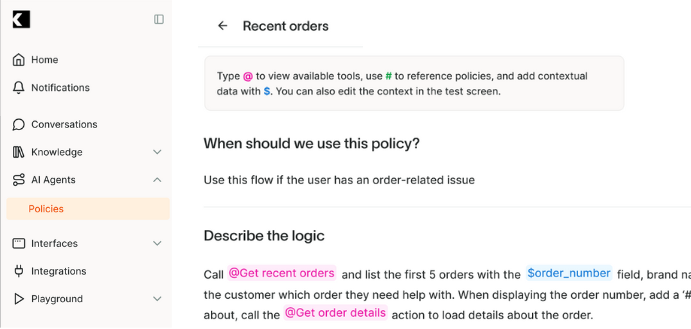Ingredients
BigCommerce, Gorgias, and Kodif.
What are AI Policies?

At Kodif, we’re excited to announce the launch of Policies—a powerful, dynamic solution designed to revolutionize the way CX managers handle customer support. Unlike traditional flows, which are rigid and complex, Policies empower non-technical users to create and manage customer interactions with ease. Written in natural language, Policies make it simple to define and refine customer experiences without needing to rely on complicated flowcharts or scripting. This approach is not only user-friendly but also self-serve, enabling CX teams to quickly translate existing Standard Operating Procedures (SOPs) into automation, saving valuable time and resources.
The flexibility of Kodif Policies ensures that businesses can offer personalized, context-driven support while continuously improving customer experiences. With Policies, you can experiment with different strategies to optimize outcomes such as CSAT, revenue, and retention—all without the need to rebuild complex workflows. Whether it’s automating routine interactions or testing new approaches for high-stakes scenarios, Policies provide a scalable, adaptable solution that aligns with your business goals. While flows still have their place in sensitive, high-risk situations, Policies offer an agile alternative that helps businesses innovate faster and deliver exceptional, tailored experiences at scale.
“Warranty Claim Policy” Ticket Type Explained
In customer support, a “Warranty Claim Policy” refers to the structured approach a company uses to manage and process customer requests related to product warranties. This policy is crucial for ensuring that customers receive the assistance they need when they experience issues with products that are still under warranty. It typically involves verifying the warranty status, validating the claim, and guiding the customer through the process of submitting necessary documentation. Effectively handling warranty claims not only enhances customer satisfaction but also reinforces trust and brand loyalty.
Which Platforms Does This AI Policy Work On?
This Warranty Claim Policy is designed to work seamlessly on BigCommerce, Gorgias, and Kodif. Additionally, Kodif integrates with all other major platforms, ensuring a versatile solution for diverse business needs.
When Should I Use This Policy?
This policy should be employed when a customer requests to file a warranty claim for a product. The process is straightforward and ensures that the customer’s needs are addressed efficiently.
Policy Logic
- Ask for the User’s Email Address
- Use @getbigcommerceaccountdetails tool to check if the user with that email address exists in BigCommerce.
- If the email address was not found, ask for a valid email address.
-
If the email address is still not found, route it to an agent for further investigation.
-
Display Recent Orders
- Use @getbigcommerceorders to retrieve the user’s recent orders.
- Display the list of recent orders and ask the user which specific order they would like to inquire about.
-
If the order was not found, route to an agent for further investigation.
-
Check Order Status
-
For the selected order, use @bigcommerceorderdetails to check the status of the order.
-
Validate Warranty Eligibility
- Check the order date and the product warranty terms (e.g., 1-year warranty).
- Use @checkwarrantyeligibility to determine if the product is still under warranty.
-
If the product is not eligible, use a macro: “Your product is no longer under warranty. Please let us know if there’s anything else we can assist you with.”
-
Create a Support Ticket for the Warranty Claim
- Ask the customer to describe the issue with the product.
- Gather order details, warranty eligibility confirmation, and instructions for the customer to send photos and additional documentation to a designated support email.
- Use a macro: “We’ve created a support ticket for your warranty claim. Please send photos of the defective product and proof of the issue to [support_email]. Our team will review your claim and get back to you within [X business days].”
If the chatbot supports attachments, request images or documents (e.g., purchase receipt, photos of the product, etc).
Example Policy
This policy should be employed when a customer requests to file a warranty claim for a product. The process ensures that the customer’s warranty claim is handled effectively and efficiently, maintaining a high level of customer satisfaction.
- Ask for the User’s Email Address
- Use @getbigcommerceaccountdetails tool to check if the user with that email address exists in BigCommerce.
- If the email address was not found, ask for a valid email address.
-
If the email address is still not found, route it to an agent for further investigation.
-
Display Recent Orders
- Use @getbigcommerceorders to retrieve the user’s recent orders.
- Display the list of recent orders and ask the user which specific order they would like to inquire about.
-
If the order was not found, route to an agent for further investigation.
-
Check Order Status
-
For the selected order, use @bigcommerceorderdetails to check the status of the order.
-
Validate Warranty Eligibility
- Check the order date and the product warranty terms (e.g., 1-year warranty).
- Use @checkwarrantyeligibility to determine if the product is still under warranty.
-
If the product is not eligible, use a macro: “Your product is no longer under warranty. Please let us know if there’s anything else we can assist you with.”
-
Create a Support Ticket for the Warranty Claim
- Ask the customer to describe the issue with the product.
- Gather order details, warranty eligibility confirmation, and instructions for the customer to send photos and additional documentation to a designated support email.
- Use a macro: “We’ve created a support ticket for your warranty claim. Please send photos of the defective product and proof of the issue to [support_email]. Our team will review your claim and get back to you within [X business days].”
If the chatbot supports attachments, request images or documents (e.g., purchase receipt, photos of the product, etc).


